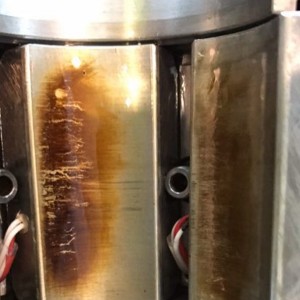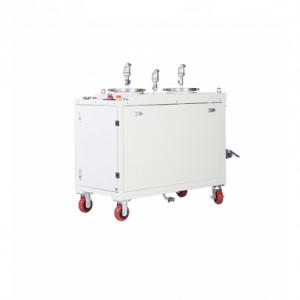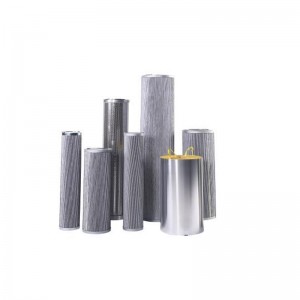Application of varnish removal technology on centrifugal compressor
EHNK50/71/32 extraction condensing steam turbine T7478 is used in the cracked gas compressor unit of Northern Huajin Chemical Industry Group Co., Ltd. The steam turbine is designed and manufactured by Hangzhou Steam Turbine Co., Ltd. Shenyang Blower Co., Ltd. is responsible for the design and manufacture of the compressor unit. The unit model is DMCL904+2MCL904+2MCL807. The compressor is composed of three cylinders, five sections and thirteen stages (fifteen impellers). The main performance parameters of the steam turbine are as follows: rated speed 5410r/min, rated power 30914KW, inlet steam pressure 10.6Mpa, inlet steam temperature 510°C, inlet steam flow 253.8 t/h, extraction steam flow 182.2t/h, compressor exhaust pressure 0.009Mpa, the discharge temperature is about 55℃. The thrust bearing type of the drive turbine of the unit is a Michel pad bearing. Each thrust bearing has two sets of thrust pad rings. Each set has 8 sector-shaped thrust pads. The lubrication between the thrust plate and the thrust pads enters through the wedge-shaped gap. The oil forms a dynamic oil film. The lubricating oil is supplied from the lower half of the bearing through the outer oil groove and enters the working area of the pad. Then it flows to the inner oil groove by centrifugal force, and then is discharged from the oil drain holes on both sides of the upper half of the bearing housing. The bearing is equipped with 3 groups of lubricating oil inlets for lubrication. Each group of oil inlets has 7 oil inlet holes and 3 oil outlet holes. The axial clearance between the thrust bearing and the thrust plate is 0.25-0.352mm, and the bearing bush clearance is 0.234-0.352. mm. It adopts the forced lubrication method of centralized oil supply at the lubricating oil station. Its appearance layout and installation are as shown in Figure 1:


figure 1
The axis diagram is as shown in Figure 2:

figure 2
|
Device name |
cracked gas compressor |
Supplier |
Shenyang Turbo Machinery Co., Ltd. |
|||
|
|
Manufacturer |
Shenyang Turbo Machinery Co., Ltd. |
||||
|
Type |
Centrifugal |
Standard |
GB3836.1-2010/API614 |
|||
|
Specifications |
DMCL904+2MCL904+2MCL807 |
document number |
Project No.: 1067 |
|||
|
Installed number |
3 |
Manufacturer's drawing number |
110.750H875/ 110.751H875 /110.752H875 |
|||
|
working medium |
pyrolysis gas |
average molecular weight |
26.73 |
|||
| Cylinder row |
low-pressure cylinder |
intermediate pressure cylinder |
high pressure cylinder |
|||
|
First stage |
Second stage |
Third stage |
Fourth stage |
Fifth stage |
||
| Main project |
Unit |
|
|
|
|
|
|
Inlet temperature |
℃ |
39.1 |
39.8 |
39.8 |
39.8 |
7.5 |
|
Outlet temperature |
℃ |
85.4 |
86.25 |
86.87 |
89.67 |
78.46 |
|
inlet pressure |
MPaG |
0.126 |
0.232 |
0.445 |
0.872 |
1.532 |
|
Outlet pressure |
MPaG |
0.254 |
0.471 |
0.905 |
1.78 |
3.901 |
| Mass flow rate (wet) |
kg/h |
236369.1 |
225666.1 |
213545.2 |
203199.7 |
198234.3 |
|
Efficiency |
% |
85.6 |
85.4 |
84.3 |
82.3 |
80.1 |
|
Rotate speed |
R.P.M |
5310 |
||||
|
critical speed of rotation |
R.P.M |
2920 |
3019 |
3681 |
||
After the equipment overhaul in July 2018, the unit is running well and the lubricating oil system is also running healthily and smoothly. Arrives on December 7th at the end of the year
On the 16th, the temperature fluctuation of the steam turbine front radial support bearing TI30950 occurred. The temperature of the TI30950 bearing fluctuates between 91.17℃-117.36℃ (vibration 15.02um), and the vibration shows a downward trend.

Figure 3: Unit bearing temperature point TI30950 trend chart
3.1 Cause analysis
3.1.1 From the perspective of the equipment itself, the turbine support bearing is a two-oil wedge bearing. From the curve, the vibration does not fluctuate significantly during the temperature rise period. When the temperature rises, the vibration shows a downward trend, and the vibration is affected by stable operation. Although the influence of oil film stability fluctuates, the amplitude is small. At the same time, the displacement of the turbine shaft is relatively stable without major fluctuations. When the problem occurred, relevant technical personnel went to the site immediately to confirm that there was no jamming of the turbine cat's claws, etc., and measured the temperature of the inlet and return oil using a hand-held temperature measuring gun, and the results were basically consistent with the temperature on the temperature indicator.
3.1.2 Looking at the maintenance data during the 2018 overhaul, the support bearing clearance of 0.31mm (required 0.3-0.358mm) is close to the lower limit. Since the rise in temperature is not accompanied by large fluctuations in vibration and the change in vibration is opposite to the rising trend of temperature, It shows that the rise in temperature is not caused by an increase in vibration. At the same time, using SG8000 online monitoring and inspection, no abnormalities were found in the GAP voltage, phase, axis trajectory, and vibration spectrum during the temperature rise period, so it is judged that there should be no problem with the equipment itself.
3.1.3 When a problem is discovered, the insulation and resistance of the instrument line are first measured. The results are normal. At the same time, the measured temperature on site is consistent with the picture. No problem is found, and the instrument failure or false signal is ruled out.
3.1.4 Adjust the operating process conditions of the unit. First, slowly reduce the lubricating oil temperature from 47°C to 42°C to alleviate the slowly rising trend of the bearing temperature. Then adjust the turbine speed, air intake temperature, air pumping volume, and lubricating oil inlet pressure. , switching oil filters, replacing filter elements, etc., but the bearing temperature still varies between 100-102℃, and the vibration varies between 16-20um. Although it has a certain mitigating effect, it does not fundamentally solve the problem.
3.1.5 This unit uses Total 46# turbine oil, which is mineral oil and its viscosity changes greatly with temperature. When the bearing temperature fluctuated, it was December, the ambient temperature was low, the lubricating oil inlet temperature was 40°C, lower than the design temperature, the freezing point of Total 46# turbine oil was -18°C, the lubricating oil flow slowed down, and the pipeline reached The pipeline at the bearing is long, the temperature of the lubricating oil will be lost during the flow process, the viscosity will increase, and the stiffness of the oil film will be affected to a certain extent. Measures such as increasing the oil temperature, increasing the insulation of the lubricating oil pipeline, and increasing the lubricating oil inlet pressure will be taken on site to ensure the lubricating oil. The viscosity has a slight effect, but the effect is not obvious.
3.1.6 The Total 46# turbine oil used in this equipment is mineral oil. When the temperature is high, the lubricating oil is easily oxidized, and the oxidation products gather on the surface of the bearing bush to form a varnish. Mineral lubricants are mainly composed of hydrocarbons, which are relatively stable at room temperature and lower temperatures. But if at high temperatures, some (even a very small number) of hydrocarbon molecules will undergo an oxidation reaction, and other hydrocarbon molecules will also undergo a chain reaction. Considering that the bearing temperature was maintained at around 90°C when the bearing was driven after maintenance, and while looking at the photos of the bearing at the maintenance site (see Figure 4), it was found that there was a varnish on the bearing (see Table 2)

Figure 4
3.1.7 The unit lubricating oil samples were sent to the Testing Institute of Guangzhou Mechanical Science Research Institute Co., Ltd. for testing and analysis. The results are shown in Table 2. The analysis results found that the MPC value was not high. According to the analysis of the test data in Table 2, the antioxidants of the three units The content has little change from that of new oil, indicating that the anti-oxidation performance is good and no obvious oxidation has occurred. However, the MPC value of the C-1300 unit is significantly higher than that of the other two units, indicating that the oxidation has just begun and there are not many insoluble substances in the oil, but on the other hand, it also means that the solubility of the oil to insoluble substances is low. Before changing the oil, the insoluble matter in the system is dissolved in the oil in use. At this time, the relative solubility of the oil in use is greater, which means it can dissolve more oxides, that is, varnish-like substances. Therefore, the oil system is in a relatively stable balance. state. After an oil change, this balance will be destroyed. Due to the oil change process, the equipment will cool down for a certain period of time. In the absence of flushing of the system, a large amount of varnish substances dissolved in the oil will deposit when the temperature decreases. When new oil circulates in the oil system, the previously deposited varnish substances will dissolve back into the new oil. If the saturated hydrocarbon content of the new oil is low and the solubility of these varnish substances is not high, then in later operations, , these insoluble matter will still settle to the surface of the parts to form a varnish, reducing the oil film thickness of the friction pair (such as sliding bearing bush, thrust bearing bush pair), causing the temperature of the bearing bush to increase.

Table 2 Lubricant varnish tendency index of three major units (December 18, 2018)
Table 2 Lubricant varnish tendency index of three major units (December 18, 2018)
3.1.8 The circulation of the oil system is continuous. On the one hand, the circulation of lubricating oil forms an oil film to lubricate the surface of the friction pair, and on the other hand, it takes away heat. The typical characteristics of the influence of varnish on centrifugal units are that it causes oil temperature to rise and fall, bearing temperature fluctuations, pressure fluctuations, control valves, vibration value fluctuations, safety valve jamming and other phenomena.
Through the above analysis, it can be determined that the varnish produced by the oxidation of the oil is the cause of the high temperature of the steam turbine thrust bearing (bearing bush) TI30950. When there is a varnish in the lubricating oil system, the dissolution and precipitation in the oil is a dynamic equilibrium system. When it reaches a saturated state, the physical properties of the varnish are polar molecules that are easily adsorbed on the bearings or bearing bushes, causing temperature fluctuations in the bearing bushes. It is a major hidden danger to safe operation.
3.2 Treatment measures
3.2.1 Replace some new oil
First, 8 barrels of new lubricating oil were added to the cracked gas unit, and the bearing temperature dropped from 102°C to 100°C. From the analysis of the phenomenon, it may be due to the oil replenishment that the lubricating oil has an enhanced ability to dissolve varnish-like substances, because the oil tank has a large installed capacity of 28 tons, the amount of oil added was relatively small, and it only lasted 3 hours before the temperature rose again. varnish substances contaminate new oil too quickly. Frequent replacement of lubricating oil is expensive and cannot solve the fundamental problem. This method should not be continued to be used.
3.2.2 Recalculate the bearing design and adjust the size of the oil inlets at both ends of the bearing as appropriate to match the lubricating oil inlet with the bearing working conditions or increase the oil inlet volume of the lower bearing, but this modification can only be carried out during overhaul.
3.2.3 Use special varnish removal equipment to circulate and filter the oil. Commonly used varnish removal technologies include electrostatic particle purification, balanced charge purification, ion exchange, depth media filtration, etc. After research, Huajin Group adopted the Kunshan Washengda WVD-Ⅱ paint removal membrane oil filter with good petrochemical performance and high reputation.
3.2.4 Strengthen the full life analysis of the in-use oil of the unit.
3.3 varnish removal effect
The varnish removal and oil purifier was used online for 3 months. On September 10, 2019, the temperature of the steam turbine thrust bearing (bearing bush) TI30950 dropped to about 92°C (as shown in Figure 5). The color of the oil has been significantly improved. Through analytical testing and external testing data analysis, the varnish tendency index of the oil has been reduced from 2.8 to 0.9, the pollution level has been reduced from NAS9 to 8, and the acid value index has been reduced from 0.064 to 0.048.


Figure 5 Thrust bearing (bearing bush) TI30950 temperature trend (after oil filtration)

Table 3 Test and analysis results of oil after filtering by oil filter
3.4 Principles of varnish removal
The varnish oil purifier has five tanks, two electrostatic adsorption tanks, two resin adsorption tanks, and one filter tank. The oil storage capacity is about 100L. The suspended varnish is removed through the electrostatic adsorption tank and the resin adsorption tank. Remove the suspended varnish and finally remove impurities to complete the purification of lubricating oil;
Through the installation and operation of the varnish removal oil filter, the problem of temperature rise of the steam turbine thrust bearing TI30950 caused by the varnish was completely solved, and huge losses caused by the shutdown of the cracked gas compressor unit were avoided. The cracked gas compressor unit was shut down for at least 3 days. The loss was 4 million yuan; the replacement of the steam turbine thrust bearing took one day, and the loss was 1 million yuan; and the loss of spare parts caused by the temperature fluctuation of the thrust bearing to the sealing components was approximately between 500,000 and 8 million yuan. The unit was filled with a total of 160 barrels of oil. After high-precision filtration through the paint removal film, the oil completely reached the qualified standards, saving 500,000 yuan in oil replacement costs.
Once a problem occurs with the large unit equipment of a chemical enterprise, multiple aspects must be considered to find the cause. Lubricating oil is the blood of equipment operation. Its monitoring the operating status of the equipment. It is one of the important parts of equipment management. At the same time, the problems it will bring cannot be ignored. The varnish is a nano-scale polar insoluble matter generated by the oxidation of the lubricating oil. As the concentration increases, when it reaches a saturated state, some of the insoluble matter will be deposited on the surface of the friction pair. Under high temperature and high pressure, over time, Over time, it hardens into a solid film covering the surface of the parts, which is the product of oxidative degradation of oil. By installing a varnish removal and oil purifier using electrostatic adsorption and ionic resin adsorption technology to monitor the varnish tendency index, the purpose of monitoring the varnish generated on the bearings and managing the varnish is achieved, ensuring the stable operation of the equipment.












